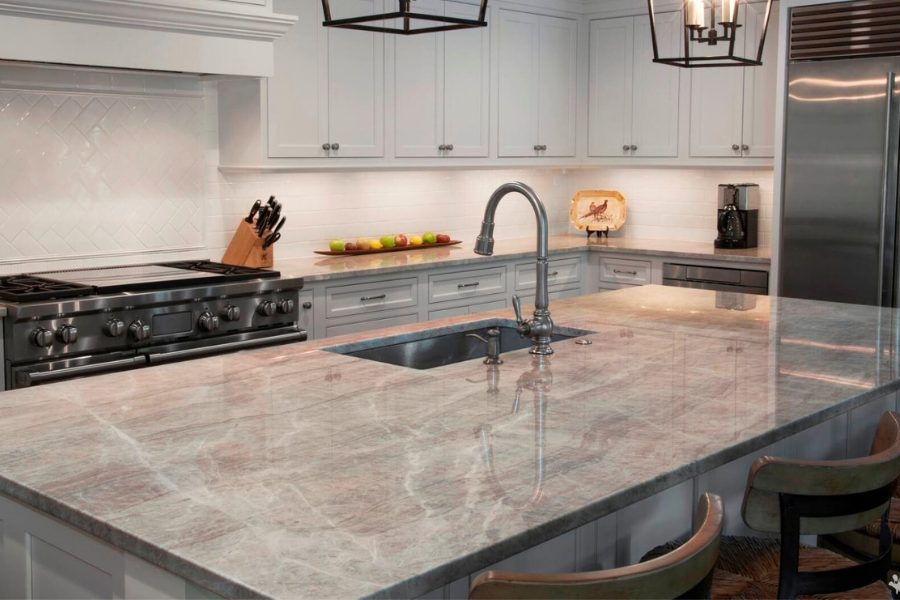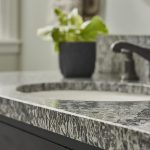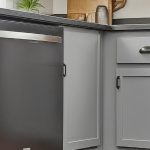Designing an outdoor kitchen is fun because you can make a place valuable and beautiful for cooking, eating, and having guests over. The stone you choose for your outdoor kitchen floor will be one of the most important choices you’ll have to make during this process. Because there are so many choices, from raw stone to manufactured materials, it can take a lot of work to figure out what to choose. To make it easier to decide, here are the steps you need to take to pick the best stone for your outdoor kitchen countertop:
- Understand Your Requirements: Consider climate, usage, upkeep, aesthetics, and kitchen renovation cost before choosing the stone for your outdoor kitchen.
- Prioritize Durability: Outdoor kitchen counters are exposed to dampness, temperature changes, and stains. Choose a stone material that can tolerate outdoor usage.
- Consider Maintenance: Consider the care needs of each stone and choose one that fits your lifestyle.
- Explore Design Options: Choose a stone that matches your outdoor kitchen’s design; consider color, texture, veining, and aesthetic.
Following these steps, you can choose a suitable stone from experts like Granite Nations for your outdoor kitchen countertop more quickly and confidently.
Choosing the Best Stone for your Outdoor Kitchen
Figuring Out What’s Needed
- The weather is rough on these surfaces; they are exposed to UV rays, water, changes in temperature, and food and drink spots are possible.
- When choosing the best stone for your outdoor kitchen countertop, the most important things to consider are how long it will last, how well it looks, and how resistant it is to the elements.
Granite: Classic Style and Longevity
- Granite is often used for outdoor cooking countertops because it is solid and looks great for a long time. It is a natural stone that doesn’t burn, scratch, or damage easily.
- Granite comes in many colors and shapes so that it can be used in various outdoor design styles, from rural to modern.
- Proper finishing is necessary to make granite more resistant to the weather and ensure it lasts long.
Quartzite: Natural Beauty with Superior Performance
- A natural stone called quartzite has marble’s beauty and granite’s strength. This stone has beautiful veining and color differences, making outdoor stoves look more elegant.
- This stone is very resistant to heat, scratches, and etching, which makes it the best stone for outdoor kitchen countertops, where long-lasting materials are needed.
- Like granite, quartzite must be sealed occasionally to keep its performance and look, especially outside.
Soapstone: Time-Tested Charm and Durability
- For outdoor cooking countertops, soapstone is a standard choice that is loved for its natural beauty and ability to handle heat. Its smooth surface and delicate veins add a bit of understated grace to places where people cook outside.
- This stone is thick and doesn’t have pores. It doesn’t stain or allow bacteria to grow, so it’s excellent for cooking and socializing.
- Soapstone is less likely to get damaged by the weather, but it should still be oiled regularly to keep its natural color and good shape.
Slate: Rustic Charm and Resilience
- Slate countertops look rough and elegant, so they’re a popular choice for outdoor kitchens that want to feel warm and welcome.
- This volcanic rock is known for being strong and resistant to damage from scratching, spots, and changes in temperature. This makes it a good choice for use outside.
- Slate’s natural roughness and rich colors go well with the outdoors, making the kitchen and scenery feel like they belong together.
Concrete: Customizable Design and Strength
- Concrete floors give outdoor kitchens many design options because Granite Nations allows people to change the colors, shapes, and textures to fit their tastes.
- If you protect and take care of your concrete floors correctly, they will last a long time and resist UV light and water.
- Adding things like strands or rebar to concrete can make it more robust in tension, which is essential for long-lasting use outside.
Porcelain: Cutting-Edge Innovation for Outdoor Living
- Porcelain countertops are a new and useful option for outdoor kitchens because they combine the beauty of natural stone with the strength of man-made materials.
- These fragile slabs are solid and light simultaneously, so they are not damaged by hits, scratches, or UV light.
- Porcelain countertops come in many different shapes, like stone and wood, so you can make your outdoor kitchen look however you want.
Conclusion
When selecting the ideal stone for your outdoor kitchen countertop installation, you must consider how long it will last, its aesthetic appeal, and the required upkeep. Some of the best choices for outdoor kitchen countertops include granite, quartzite, soapstone, slate, concrete, and porcelain. Each material offers unique benefits and design options that enhance the cooking and dining experience outdoors. By choosing the appropriate stone and ensuring proper care, you can create an outdoor kitchen that not only looks great and functions well but also endures for years to come.
Frequently Asked Questions
What stone is best for outdoor countertops?
Granite: Granite is a popular choice for outdoor countertops because it is highly durable and resistant to heat, scratches, and stains. It also comes in various colors and patterns, so you can choose a style that complements your outdoor decor.
What is the best countertop for an outside kitchen?
Granite is a popular, durable option. It stands up well to the elements, doesn’t absorb stains or odors as quickly as other stones, and shouldn’t fade in the sun.
Is granite or quartzite better for outdoor kitchens?
With quartzite, you won’t need to worry about its color fading in the sunlight, making it another excellent choice for an outdoor kitchen countertop. However, unlike granite, it can’t withstand high temperatures.













